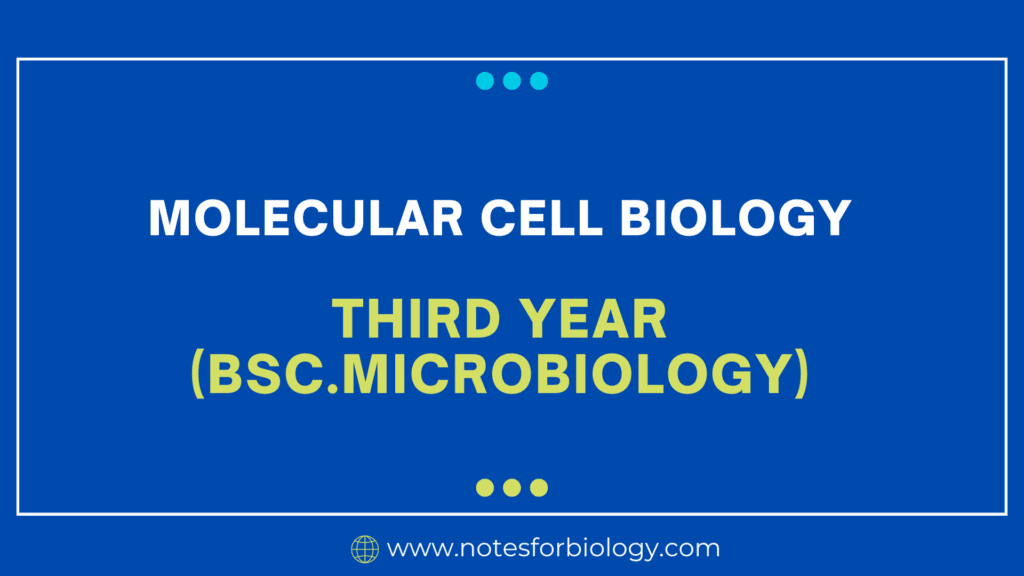Description of the Course of Molecular Cell Biology
| Course Title: | Molecular Cell Biology |
| Course No: | MB 301 (Major) |
| Nature of the Course: | Theory |
| Full Marks: | 100 |
| Pass Marks: | 35 |
| Total Lecture Hours: | 150 |
| Years: | Third Years(3rd) |
Course Objectives
After completion of the course, the students will be able to:
a) Understand how cell evolved and different organelles of the cell
b) Understand role and importance of inter and intra cellular transport in cell
c) Understand the concept of cell communication, its significance and importance
d) Know the importance of cytoskeleton for the integrity of cell and its dynamic nature
Course Content of Molecular Cell Biology
A. Theory
Molecular Cell Biology Theory
| S.N | Topic/ Chapter Name | Credit Hours |
| 1. | An Overview of Cells Origin of life on Earth: import of life through meteorites, theory of chemical evolution, primitive earth conditions: anoxic reductive atmosphere, evolution of biomolecules to cell, evolution of prokaryotic cell, evolution of cellular organelles and eukaryotic cells | 5 hrs |
| 2. | Cell Structure and Function Introduction to cytoplasmic organelles and cytoskeleton: protoplasm, mitochondria, chloroplast, endoplasmic reticulum, golgi complex, lysosome, endosome, ribosome, centriole, microbodies: peroxisomes and glyoximes, flagella, cilia, cell wall, extracellular matrix | 25 hrs |
| 3. | Nucleus Chromosomes, chromatin and nucleosome, chromosome structure in bacteria and eukaryotes, centromere, telomere, hetero and euchromatin, nucleosome model and radial-loop scaffold model | 15 hrs |
| 4. | Membrane Structure and Transport Models of membrane structure, membrane lipids, proteins and carbohydrates and their functions, fluidity of membrane, lipid raft, membrane electric potential, transport across cell membranes: diffusion of small molecules across phospholipid bilayers, uniporter catalyzed transport, cotransport by symporters and antiporters, active transport by ATP powered pumps | 20 hrs |
| 5. | Structure and Organization of Actin Filaments Actin cytoskeleton, dynamics of actin assembly, myosin: the actin motor protein, actin and myosin in nonmuscle cells, cell locomotion | 12 hrs |
| 6. | The Microtubule Cytoskeleton Microtubule structures, components of microtubules and dynamics of microtubule assembly, associated proteins, kinesin, dynein, and intracellular transport, cilia and flagella movement, motor proteins during mitosis, microfilaments, intermediate filaments | 18 hrs |
| 7. | Intracellular Transport Transport of molecules between nucleus, mitochondria, chloroplast and other cell organelles, vesicular transport: transport from ER to cell organelles; transport across plasma membrane: endocytosis (phagocytosis, pinocytosis, receptor mediated endocytosis) and exocytosis | 15 hrs |
| 8. | Cell Signaling Signaling molecules and their receptors (extracellular and intercellular signaling molecules, ligands and receptors), local and long distance signaling, pathways of intracellular signal transduction, types of extracellular signaling processes, Intracellular second messengers with examples (cyclic nucleotides, phospholipids, calcium and protein kinases as elements of signal transduction), third messengers (DNA binding proteins) and role of signaling molecules in gene activation, interaction and regulation of signaling pathways as related to G-Protein coupled receptor signaling mechanisms, receptor tyrosine kinase based signaling mechanisms, receptor guanylyl cyclase based signaling mechanisms, Gated ion channel based signaling mechanisms, Adhesion receptor based signaling mechanisms | 25 hrs |
| 9. | The Cell Cycle Regulating eukaryotic cell cycle, cyclin dependant kinase regulation during mitosis, check points in cell cycle regulation, components of cell cycle control system: intracellular and extra-cellular control of cell division, mitosis and meiosis, programmed cell death (apoptosis), intrinsic and extrinsic pathways of cell death, apoptosis in relation with cancer and viral disease (AIDS), stem cells, embryonic stem cells and therapeutic cloning | 15 hrs |
| Total | 150 hrs |
Recommended Readings
Text books
- Lodish H, Berk A, Matsudaira P, Kaiser C, Krieger M, Scott M, Zipursky L and Darnell J (2003). Molecular Cell Biology, 5th Edition. W.H Freeman and Company.
- Alberts B, Johnson A, Lewis J, Raff M, Roberts K and Walter P (2002). Molecular Biology of the Cell, 4thEdition. New York: Garland Science.
B. Practical
Description of the Course of Molecular Cell Biology Practical
Molecular Cell Biology Practical
| Course Title: | Molecular Cell Biology Practical |
| Course No: | MB 302 (Major) |
| Nature of the Course: | Practical |
| Full Marks: | 50 |
| Pass Marks: | 20 |
| Year: | Third Years(3rd) |
| Total Lecture Hours: | 180 |
Course Content of Molecular Cell Biology
After completion of the course, the students will be able to:
a) develop skills in cell counting, be able to isolate cell organelles and analyze basic cellular activity
| S.N | Course Contents |
| 1. | To perform differential centrifugation for separation of different cell organelles |
| 2. | To isolate mitochondria from different samples |
| 3. | To perform cell counting using hemocytometer |
| 4. | To perform lysis of cell using different techniques |
| 5. | Selective permeability of membrane (artificial membrane: cellophane) |
| 6. | Analysis of sub-cellular fraction: Mitochondria by measuring succinate dehydrogenase activity, lysosomal fraction by protease activity |
| 7. | Isolation of chloroplast from leafy vegetables (e.g. spinach, mustard, lettuce) |
| 8. | Extraction of brain lipid |
| 9. | Quantitative analysis of lipid classes by TLC |
| 10. | DNA extraction from eukaryotic and prokaryotic cells |

